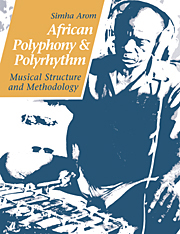Book contents
- Frontmatter
- Contents
- List of illustrations
- Foreword by György Ligeti
- Preface
- Acknowledgements
- BOOK I THE MUSIC OF THE CENTRAL AFRICAN REPUBLIC
- BOOK II AFRICAN POLYPHONIC MUSIC
- BOOK III TECHNICAL TOOLS: METHODS OF RECORDING POLYPHONIC MUSIC FOR TRANSCRIPTION
- BOOK IV THEORETICAL TOOLS
- BOOK V THE ORGANISATION OF TIME IN AFRICAN MUSIC
- BOOK VI STRUCTURAL PRINCIPLES AND THEIR APPLICATION
- Conclusion
- Bibliography
Conclusion
Published online by Cambridge University Press: 27 January 2010
- Frontmatter
- Contents
- List of illustrations
- Foreword by György Ligeti
- Preface
- Acknowledgements
- BOOK I THE MUSIC OF THE CENTRAL AFRICAN REPUBLIC
- BOOK II AFRICAN POLYPHONIC MUSIC
- BOOK III TECHNICAL TOOLS: METHODS OF RECORDING POLYPHONIC MUSIC FOR TRANSCRIPTION
- BOOK IV THEORETICAL TOOLS
- BOOK V THE ORGANISATION OF TIME IN AFRICAN MUSIC
- BOOK VI STRUCTURAL PRINCIPLES AND THEIR APPLICATION
- Conclusion
- Bibliography
Summary
Ethnomusicology, which strictly speaking is the study of ethnic music, and musical anthropology, which is primarily concerned with the role music plays in a given society and the way it interacts with the surrounding cultural context, are often treated as synonyms. This situation is doubtless a consequence of the rapid development of a young discipline.
The reader is now aware that our own perspective is specifically ethnomusicological: our purpose is to study certain musical techniques which are practised in societies that are generally made the subject of ethnological description.
Our initial objective was to discover the principles, or the underlying theory, governing polyphonic and polyrhythmic forms of music in a specific geocultural region. But a valid theory must be supported by the convergence of data gathered by observation and confirmed by experience, with pertinent statements regarding musical practice elicited from the traditional musicians themselves. We are therefore logically required to sustain a constant dialogue between ‘objective’ and cultural data, or equivalently, between the ways in which the traditional musician and the researcher understand the same object.
As we understand it, the proper task of ethnomusicology is to study the principles governing all forms of ethnic music within their cultural context, i.e., in the area where people actually use them, and where light can be thrown on them from within.
This work has both descriptive and methodological aims. We would have been unable to decipher and transcribe Central African polyphony if we had not developed a suitable and previously non-existent methodological tool. That is why we have felt obliged to give a precise description of this tool and describe in detail how it is to be used.
- Type
- Chapter
- Information
- African Polyphony and PolyrhythmMusical Structure and Methodology, pp. 655 - 659Publisher: Cambridge University PressPrint publication year: 1991



